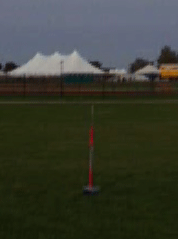
When reading about new discoveries from distant worlds like the moon, Mars and Mercury, you often read about the sizes of their craters, canyons, and mountains. Maybe you have stopped to wonder, "How do they measure these sizes, if no people or robots have been on the ground to measure them?" This activity will help you answer this question: you will measure the sizes of objects on the ground in a video taken from an Estes Oracle model rocket. From groups of frames in the video, you can meaure the rocket's height, velocity and acceleration at different points in its flight path.

Series #4 -- 13 April 2011 at about 6pm from about 300 m Northeast of the BSGU football stadium:
Series #3 -- 10 July 2010 at about noon from the outdoor track near the stadium at Bowling Green State University:
Series #1 -- 5 October 2008 at about 5pm from the athletic fields near the stadium and track at BGSU:
Calibration #1 -- use these to detemine the angular size (in degrees) of the camera's field of view. The scale on the chalkboard is in meters, with small ticks every 10 cm:
Calibration #2 -- Use this to determine the frame rate of the camera (#frames/second), so that you know the amount of time between one frame and the next, "Delta t":
Other fun videos taken with "AstroCam"-- you may be able to apply these techniques to them too.
Teachers aids -- a powerpoint introduction to the topic and a student handout (also .docx). I find I can cover most of this material in two 80 min periods, though the pace is brisk. My handout is spare, providing basic structure that encourages the students to find creative solutions to the problem (in groups of 2-4), while I roam the classroom providing hints and clarification. I've thought about writing a more detailed "guided inquiry" style handout that walks the students through the process in a more organized, cookbook fashion (encourage me to make one if you are interested). I will gladly send teachers answer keys (please provide some way for me to confirm you are a teacher, e.g. a website from your school with a faculty roster and list of email addresses would do). If you use this activity (or your own derivative of it, which I encourage), please drop me a line and let me know how it went, and what could be improved!